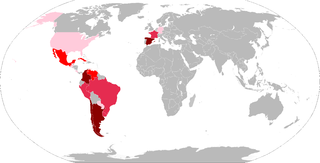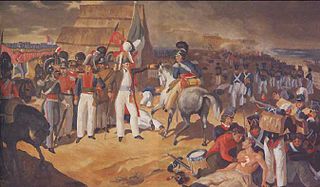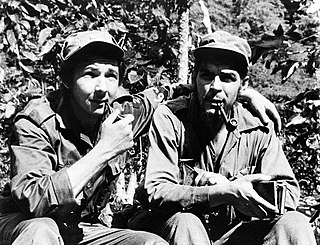
A diaspora is a scattered population whose origin lies in a separate geographic locale. In particular, diaspora has come to refer to involuntary mass dispersions of a population from its indigenous territories, most notably the expulsion of Jews from the Land of Israel and the fleeing of Greeks after the fall of Constantinople. Other examples are the African transatlantic slave trade, the southern Chinese or Indians during the coolie trade, the Irish during and after the Irish Famine, the Romani from India, the Italian diaspora, the exile and deportation of Circassians, Expulsion of the Acadians, and the emigration of Anglo-Saxon warriors and their families after the Norman Conquest of England.
Mambo is a genre of Cuban dance music pioneered by the charanga Arcaño y sus Maravillas in the late 1930s and later popularized in the big band style by Pérez Prado. It originated as a syncopated form of the danzón, known as danzón-mambo, with a final, improvised section, which incorporated the guajeos typical of son cubano. These guajeos became the essence of the genre when it was played by big bands, which did not perform the traditional sections of the danzón and instead leaned towards swing and jazz. By the late 1940s and early 1950s, mambo had become a "dance craze" in the United States as its associated dance took over the East Coast thanks to Pérez Prado, Tito Puente, Tito Rodríguez and others. In the mid-1950s, a slower ballroom style, also derived from the danzón, cha-cha-cha, replaced mambo as the most popular dance genre in North America. Nonetheless, mambo continued to enjoy some degree of popularity into the 1960s and new derivative styles appeared, such as dengue; by the 1970s it had been largely incorporated into salsa.
The music of Cuba, including its instruments, performance and dance, comprises a large set of unique traditions influenced mostly by west African and European music. Due to the syncretic nature of most of its genres, Cuban music is often considered one of the richest and most influential regional musics of the world. For instance, the son cubano merges an adapted Spanish guitar (tres), melody, harmony, and lyrical traditions with Afro-Cuban percussion and rhythms. Almost nothing remains of the original native traditions, since the native population was exterminated in the 16th century.
Chinese Cubans are Cubans of full or mixed Chinese ancestry who were born in or have immigrated to Cuba. They are part of the ethnic Chinese diaspora.
Contradanza is the Spanish and Spanish-American version of the contradanse, which was an internationally popular style of music and dance in the 18th century, derived from the English country dance and adopted at the court of France. Contradanza was brought to America and there took on folkloric forms that still exist in Mexico, Venezuela, Colombia, Peru, Panama and Ecuador.

The Basque diaspora is the name given to describe people of Basque origin living outside their traditional homeland on the borders between Spain and France. Many Basques have left the Basque Country for other parts of the globe for economic and political reasons, with substantial populations in Colombia, Argentina and Chile with those of Basque ancestry in the hundreds of thousands; Mexico, Cuba, Venezuela and Uruguay, Canada, and the United States.
Russian Americans are Americans who trace their ancestry to Russia, the former Russian Empire, or the former Soviet Union. The definition can be applied to recent Russian immigrants to the United States, as well as to settlers of 19th-century Russian settlements in northwestern America.

Haiti has a sizable diaspora, present chiefly in the Dominican Republic, the United States, Canada, Cuba, the Bahamas, and France. They also live in other countries like Belgium, Jamaica, Turks and Caicos, Mexico, U.S. Virgin Islands, Brazil and Chile, among others.
European emigration can be defined as subsequent emigration waves from the European continent to other continents. The origins of the various European diasporas can be traced to the people who left the European nation states or stateless ethnic communities on the European continent.
The Vietnamese people in France consists of people of Vietnamese ancestry who were born in or immigrated to France. Their population was over 300,000 as of 2014.

Cuban culture encompasses a wide range of dance forms. The island's indigenous people performed rituals known as areíto, which included dancing, although little information is known about such ceremonies. After the colonization of Cuba by the Spanish Kingdom, European dance forms were introduced such as the French contredanse, which gave rise to the Cuban contradanza. Contradanza itself spawned a series of ballroom dances between the 19th and 20th centuries, including the danzón, mambo and cha-cha-cha. Rural dances of European origin, such as the zapateo and styles associated with punto guajiro also became established by the 19th century, and in the 20th century son became very popular. In addition, numerous dance traditions were brought by black slaves from West Africa and the Congo basin, giving rise to religious dances such as Santería, yuka and abakuá, as well as secular forms such as rumba. Many of these dance elements from European dance and religious dances were fused together to form the basis of la técnica cubana. Cuban music also contributed to the emergence of Latin dance styles in the United States, namely rhumba and salsa.

The Spanish attempts to reconquer Mexico were an effort by the Spanish government to regain possession of its former colony of Mexico, resulting in episodes of war comprised in clashes between the newly born Mexican nation and Spain. The designation mainly covers two periods: the first attempts occurred from 1821 to 1825 and involved the defense of Mexico's territorial waters, while the second period had two stages, including the Mexican expansion plan to take the Spanish-held island of Cuba between 1826 and 1828, and the 1829 expedition of Spanish General Isidro Barradas, which landed on Mexican soil with the object of reconquering Mexican territory. Although the Spanish never regained control of the country they did damage the fledgling Mexican economy.
The Spanish diaspora consists of Spanish people and their descendants who emigrated from Spain. The diaspora is concentrated in places that were part of the Spanish Empire. Countries such as Mexico, the Dominican Republic, Peru, Uruguay, Venezuela, Chile, Colombia, Argentina, Paraguay, Cuba, Nicaragua and, to a lesser extent, Brazil, the United States, Canada and continental Europe.

A neo/new diaspora is the displacement, migration, and dispersion of individuals away from their homelands by forces such as globalization, neoliberalism, and imperialism. Such forces create economic, social, political, and cultural difficulties for individuals in their homeland that forces them to displace and migrate.

There is a significant Colombian diaspora in Mexico. According to the 2010 census, there were 13,922 Colombian citizens residing in Mexico, making them the largest South American immigrant community in Mexico.

There is a small Chilean diaspora in Mexico. According to the 2010 census, there were 5,267 registered Chilean citizens living in Mexico, an increase from the 3,848 registered in the 2000 census. Chilean immigrants constitute the fifth largest community of South Americans in Mexico and the fifteenth largest immigrant community overall.

The Venezuelan refugee crisis, the largest recorded refugee crisis in the Americas, refers to the emigration of millions of Venezuelans from their native country during the presidencies of Hugo Chávez and Nicolás Maduro because of the Bolivarian Revolution. The revolution was an attempt by Chávez and later Maduro to establish a cultural and political hegemony, which culminated in the crisis in Bolivarian Venezuela. The resulting refugee crisis has been compared to those faced by Cuban exiles, Syrian refugees and those affected by the European migrant crisis. The Bolivarian government has denied any migratory crisis, stating that the United Nations and others are attempting to justify foreign intervention within Venezuela.
As of the 2011 census, the number of immigrants in Costa Rica totaled about 390,000 individuals, or about 9% of the country's population. Following a considerable drop from 1950 through 1980, immigration to Costa Rica has increased in recent decades.

Venezuelan Mexicans are Mexicans who trace their heritage, or part of their heritage, to the nation of Venezuela. As of 2015, Venezuelans were the fifth largest immigrant group in Mexico, following Americans, Guatemalans, Spaniards and Colombians.



















